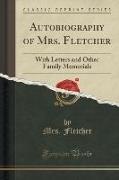Read more
Excerpt from Autobiography of Mrs. Fletcher: With Letters and Other Family Memorials
Birth at Orton, January l77o - Her mother's death - Her mother's friendship at school - Mrs. Brudenell's history - Happy childhood at. Oxton - The Dawson family - Mrs. Brudenell's separation from her husband, 1776 Settles at Orton - The mother-want supplied by Aunt Dawson - Cousins at Wighill Grange - Happy days there - The Hill family - Her aunt Mary Hill - Her love of hunting cured - Mr. Hill's letter to his son, 1767 - Traditions in the Hill family of Grace Hill and Will Hill at Marston Moor -8ir George Savile in l779 - Traditions of her youthful days Sam¿er disclosures - Account of Oxton scenery and May-day festivities - First grief going to Manor School - Life there Friendships formed there - Leaves school in summer, 1786 - 5 ome life and happiness - Happy Highland tour - Ann Yearsley, E. Anthony, and Sarah Watson the good servant - Death of grand mother, 1787 - First lowers - First meeting with Mr. Fletcher, 1787 - First impressioné deepened in 1783 E. Cartwright's friendship - George Crabbe's visit with his wife - Recollections of John Wesley - Rev. J. Cloves - Second visit to Perth - Visit to Ripon - Lord Grantley Mr. Fletcher's letter in 1787 Corre spondence continued with Mr. Fletcher - Her father's strong op position to the marriage - Her engagement - Extract from letters to Mr. Fletcher - Marriage, 16th July moi - Sorrowful feelings Re¿ections on that event - Letter to Miss cleaverhmr. Cart wright's lines to E. D. In a blank leaf of Lavater's work.
About the Publisher
Forgotten Books publishes hundreds of thousands of rare and classic books. Find more at www.forgottenbooks.com
This book is a reproduction of an important historical work. Forgotten Books uses state-of-the-art technology to digitally reconstruct the work, preserving the original format whilst repairing imperfections present in the aged copy. In rare cases, an imperfection in the original, such as a blemish or missing page, may be replicated in our edition. We do, however, repair the vast majority of imperfections successfully; any imperfections that remain are intentionally left to preserve the state of such historical works.

